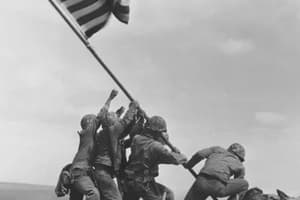Podcast
Questions and Answers
Which of the following was Harry Truman's stated reason for authorizing the use of the atomic bomb against Japan?
Which of the following was Harry Truman's stated reason for authorizing the use of the atomic bomb against Japan?
- Using the atomic bomb would prevent the need for a costly invasion of Japan (correct)
- To test the weapon's efficiency
- To seek unconditional surrender
- To demonstrate military power
Which of the following was most responsible for the change shown between 1938 and 1942?
Which of the following was most responsible for the change shown between 1938 and 1942?
- Rise of authoritarian regimes
- Industrial mobilization related to the Second World War (correct)
- Economic recession
- Increase in agricultural production
What was the purpose of John Paton Davies' observations on the struggle for power in China?
What was the purpose of John Paton Davies' observations on the struggle for power in China?
Negotiating a peaceful settlement in China to limit Soviet influence after the Second World War
Which message did the United States government most likely intend to impart in the Second World War poster?
Which message did the United States government most likely intend to impart in the Second World War poster?
What best explains an effect of the events described in the Jim Crow segregation excerpt?
What best explains an effect of the events described in the Jim Crow segregation excerpt?
Which factor prompted United States involvement in military actions during the Second World War?
Which factor prompted United States involvement in military actions during the Second World War?
One major effect of the Second World War was increased opportunities for women in
One major effect of the Second World War was increased opportunities for women in
What was a major effect of American participation in the Second World War on the home front?
What was a major effect of American participation in the Second World War on the home front?
How is the American home front in the Second World War best described?
How is the American home front in the Second World War best described?
What did the Rosie the Riveter campaign during the Second World War encourage women to do?
What did the Rosie the Riveter campaign during the Second World War encourage women to do?
Flashcards are hidden until you start studying
Study Notes
Harry Truman and the Atomic Bomb
- Harry Truman authorized the use of the atomic bomb to avoid a costly invasion of Japan.
Industrial Mobilization (1938-1942)
- Industrial mobilization for WWII significantly transformed the U.S. economy between 1938 and 1942.
China and U.S. Diplomacy
- U.S. diplomat John Paton Davies advocated for negotiations in China to minimize Soviet influence post-WWII.
- Promoted cooperation between the Kuomintang (Nationalist Party) and the Chinese Communist Party.
African American Workforce in WWII
- WWII posters aimed to increase acceptance of African American workers in industrial jobs.
Jim Crow and Segregation in Military
- Despite the abolition of slavery, Jim Crow segregation persisted in the military during WWII.
- Over 2.5 million African Americans registered for the draft, with 1 million serving.
Double V Campaign
- The Pittsburgh Courier launched the Double V campaign, highlighting the fight for freedom abroad and equality at home.
U.S. Involvement in WWII
- The surprise attack on Pearl Harbor prompted U.S. military involvement in WWII.
Opportunities for Women
- The war created significant opportunities for women in industrial employment and factory work.
Economic Impact of WWII on Home Front
- The American home front experienced economic revitalization due to military spending during the war.
Rosie the Riveter Campaign
- The Rosie the Riveter campaign encouraged women to enter the labor force, symbolizing their contribution to the war effort.
Studying That Suits You
Use AI to generate personalized quizzes and flashcards to suit your learning preferences.





